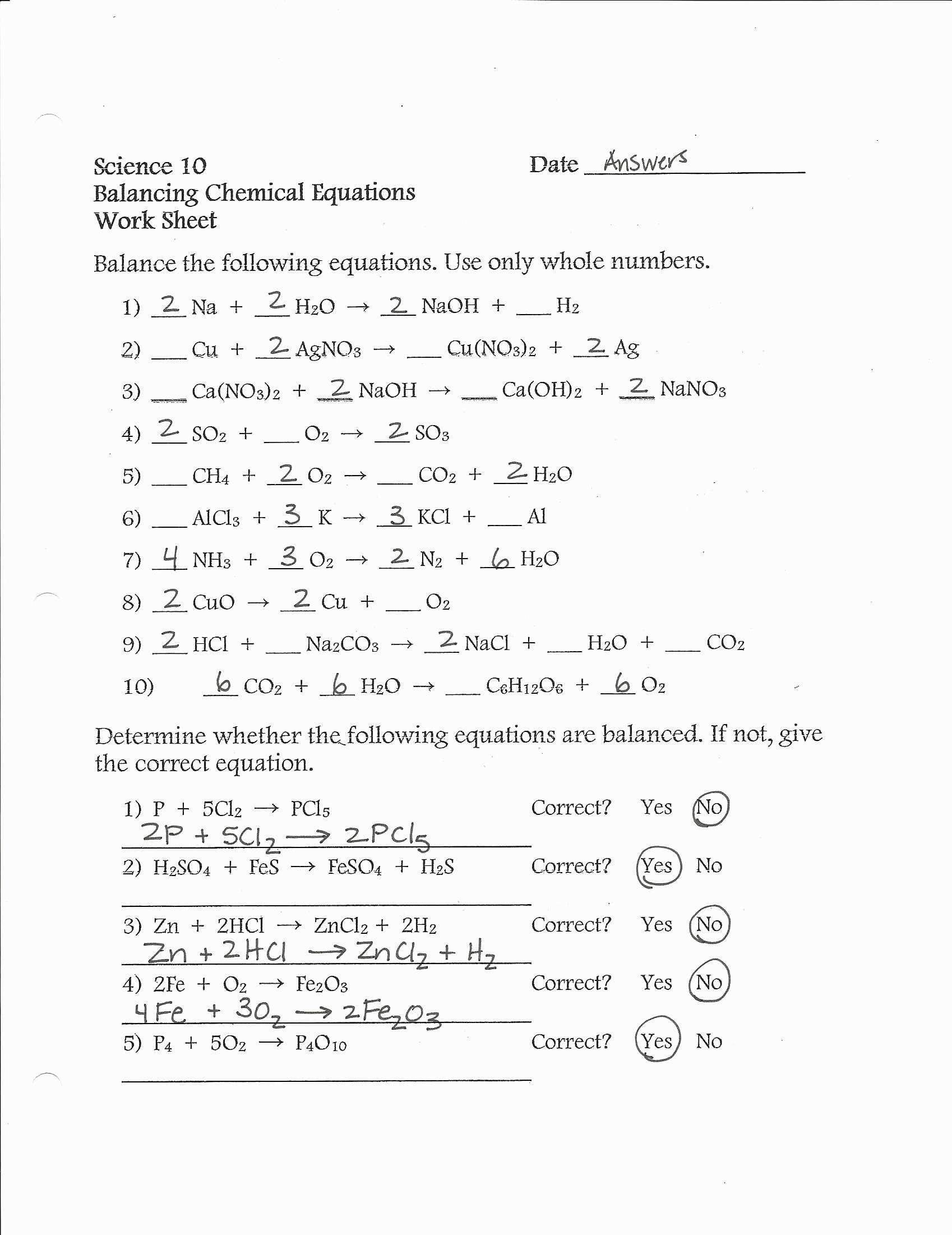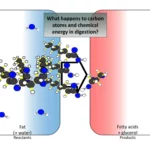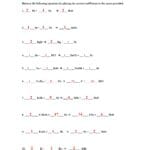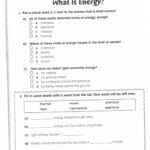Unlock the secrets of balancing chemical equations with this comprehensive guide and collection of printable worksheets with answers. From foundational concepts to advanced techniques, you’ll have everything you need to become a stoichiometry master. Dive in and conquer the world of chemical equations!
Why Balancing Equations is Crucial
Imagine a recipe – you need precise ingredient amounts for the perfect dish. Chemical equations are similar: balancing ensures the “ingredients” (atoms) are present in the correct proportions on both sides of the reaction. This is essential due to the Law of Conservation of Mass, which states that matter cannot be created or destroyed in a chemical reaction. All starting atoms must be accounted for in the products. Balancing also allows accurate stoichiometric calculations, predicting reactant and product quantities, crucial in fields from baking to rocket science.
Two Methods for Balancing Equations
Two common approaches exist for balancing chemical equations, each with its own strengths:
1. The Inspection Method
This intuitive trial-and-error method involves adjusting coefficients (numbers in front of chemical formulas) until the number of each element’s atoms is equal on both sides. It’s often the easiest approach for simpler equations.
- Start by balancing elements appearing in the fewest compounds.
- Balance more complex compounds next, saving pure elements (like O₂ or H₂) for last.
- Double-check your work to ensure everything is perfectly balanced.
2. The Algebraic Method
This systematic approach, helpful for complex equations, involves assigning variables to coefficients and solving a system of equations.
- Assign a unique variable (x, y, z, etc.) to each coefficient.
- Write an equation for each element, equating the number of atoms on both sides.
- Solve for the variables; these become your coefficients. An educated guess for one variable might be needed to get started.
Types of Chemical Reactions
Several main reaction types exist:
- Combination (Synthesis): A + B → AB (Two or more substances combine to form a single product.)
- Decomposition: AB → A + B (A compound breaks down into simpler substances.)
- Single Displacement: A + BC → AC + B (One element replaces another in a compound.)
- Double Displacement: AB + CD → AD + CB (Two compounds exchange ions.)
- Combustion: Often involves a hydrocarbon reacting with oxygen to produce carbon dioxide and water, generating heat and light.
Practice Balancing Equations: Examples and Resources
Mastery requires practice. Here are examples and resources:
Example Problems
- Beginner: H₂ + O₂ → H₂O (Hint: 2H₂ + O₂ → 2H₂O)
- Intermediate: Fe + Cl₂ → FeCl₃ (Hint: 2Fe + 3Cl₂ → 2FeCl₃)
- Advanced: KMnO₄ + H₂SO₄ + KHSO₃ → KHSO₄ + MnSO₄ + H₂O (Hint: 2KMnO₄ + 3H₂SO₄ + 5KHSO₃ → 5KHSO₄ + 2MnSO₄ + 3H₂O)
Finding More Practice
- Worksheets: Numerous printable worksheets with answer keys are available online.
- Online Resources: Sites like Khan Academy, ChemLibre offer tutorials, practice problems, and simulations.
- Textbooks and Study Guides: Excellent resources for in-depth explanations and practice problems.
Would you like to prove your knowledge about classifying matter? If so, follow this classifying matter worksheet and test your skills. And for legal affairs enthusiasts, the Chimel v. California case study is a must-read. Delve into the nuances of search and seizure law through this captivating account.
The Importance of Stoichiometry
Stoichiometry, the math behind chemical reactions, uses balanced equations to determine reactant and product quantities, much like a recipe. This is based on the Law of Conservation of Mass – matter changes form, but atoms are conserved. A balanced equation acts as a blueprint, with coefficients representing mole ratios, telling us how reactants combine and products form. Just like a recipe needing specific ingredient amounts, stoichiometry identifies limiting reactants and predicts theoretical yields.
| Concept | Analogy | Stoichiometry Application |
|---|---|---|
| Recipe | Balanced Equation | Represents the reaction |
| Ingredients | Reactants | Substances consumed |
| Finished Product | Products | Substances formed |
| Amounts | Mole Ratios | Proportions of reactants/products |
| Limiting Ingredient | Limiting Reactant | Determines max product formed |
Stoichiometry has far-reaching applications: optimizing industrial processes, determining drug dosages, analyzing environmental reactions, and even everyday cooking. Current research explores complex reaction stoichiometry, including catalysis and material science, continually refining our understanding and expanding its applications. While principles are established, ongoing research suggests our understanding of specific reaction mechanisms and yields might evolve. Stoichiometry provides a powerful framework for making predictions and interpretations within the fascinating world of chemical transformations.
Mastering Balancing Equations with Solved Examples
Balancing equations is fundamental to chemistry, ensuring the Law of Conservation of Mass is upheld and allowing accurate stoichiometric calculations. It predicts product amounts, reactant needs, and potential energy changes.
Step-by-Step Balancing Guide
- Write the Unbalanced Equation: Your starting point.
- Atom Inventory: List each element’s atoms on both sides.
- Balancing Act: Adjust coefficients to equalize atom counts on both sides, without changing subscripts.
- Double-Check: Verify equal atom counts on both sides.
Worked Examples
- Simple: C₃H₈ + O₂ → H₂O + CO₂ (C₃H₈ + 5O₂ → 4H₂O + 3CO₂)
- Trickier: Al + HCl → AlCl₃ + H₂ (2Al + 6HCl → 2AlCl₃ + 3H₂)
- Multi-element: Na₂CO₃ + HCl → NaCl + H₂O + CO₂ (Na₂CO₃ + 2HCl → 2NaCl + H₂O + CO₂)
- Complex: C₇H₆O₂ + O₂ → CO₂ + H₂O (2C₇H₆O₂ + 15O₂ → 14CO₂ + 6H₂O)
- Challenging: Mg₃Si₂O₅(OH)₄ + CO₂ → MgCO₃ + SiO₂ + H₂O (Mg₃Si₂O₅(OH)₄ + 4CO₂ → 3MgCO₃ + 2SiO₂ + 2H₂O) (Starting with a coefficient of 1 for the complex reactant can be helpful, as sometimes suggested by resources like Chemrevise.)
Helpful Hints
- Balance less common elements first.
- Treat unchanged polyatomic ions as single units.
- Use fractions if needed, then multiply by the least common denominator for whole numbers.
- Always double-check!
Common Pitfalls
- Changing subscripts.
- Incomplete balancing.
- Unsimplified coefficients.
Balancing equations is the foundation of stoichiometry, crucial in fields like chemical engineering, medicine, and environmental science. Ongoing research may refine our understanding of these principles, so continued learning is essential.
Beginner-Level Balancing Equation Worksheets with Answers
Master balancing chemical equations with these beginner-friendly worksheets and answers. Balancing, like adjusting a recipe, ensures equal atom counts on both sides of the equation, upholding the Law of Conservation of Mass. These worksheets offer a structured approach to build your confidence.
Step-by-Step Guide
- Take Inventory: List each element’s atoms on both sides.
- Adjust the Portions: Change molecule counts (and atom counts) using coefficients in front of formulas, not subscripts. Balance elements in single compounds on each side first.
- Double-Check Your Recipe: Recount atoms on both sides.
Helpful Hints
- Balance lone elements first.
- Treat polyatomic ions as groups.
- Use fractions as intermediates, then multiply for whole numbers.
- Take breaks if stuck.
Importance of Balancing
Balancing ensures adherence to the Law of Conservation of Mass and enables predicting reactant/product amounts. It’s a core concept in chemistry, extending to complex reactions. Ongoing research reveals the nuances of chemical reactions, suggesting continuous learning is crucial.
These worksheets are your starting point toward mastering this skill. Remember that balancing equations is essential for stoichiometric calculations and has many real-world applications, from determining drug dosages to optimizing industrial production. It also requires a keen conceptual understanding and application of the foundational rules of chemistry. Ongoing research is always adding to our knowledge of chemistry, so keep an open mind and continue learning. This information gives you a head start on understanding the complexities and importance of balanced chemical equations.










1 thought on “Balancing Chemical Equations Worksheets with Answers: Your Guide to Stoichiometry Mastery & Practice”
Comments are closed.